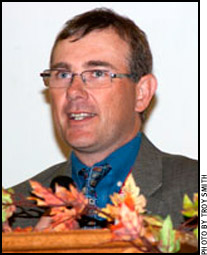Capturing Added Value for Calves
![]() Creating value in a calf crop seems simple enough. You breed good cattle and manage them well. Then, you market the increase. Well, it might not be quite as simple as it seems. According to Burlington, Colo., cow-calf producer and beef industry writer Troy Marshall, that third step can be downright difficult. Speaking to fellow cow-calf producers gathered for the 2011 Range Beef Cow Symposium in Mitchell, Neb., Marshall shared his thoughts on creating and capturing added value.
Creating value in a calf crop seems simple enough. You breed good cattle and manage them well. Then, you market the increase. Well, it might not be quite as simple as it seems. According to Burlington, Colo., cow-calf producer and beef industry writer Troy Marshall, that third step can be downright difficult. Speaking to fellow cow-calf producers gathered for the 2011 Range Beef Cow Symposium in Mitchell, Neb., Marshall shared his thoughts on creating and capturing added value.
Marshall noted how excess capacity in U.S. feedyards and a short supply of feeder cattle means there is plenty of competition among willing buyers. It pushes prices higher.
However, Marshall reminded his audience, it also creates a marketing challenge for cow-calf producers striving to market added-value calves. Because buyers really need cattle and bid accordingly, there is less price differentiation — less premium for cattle that truly represent more value.

Troy Marshall
"I believe we are going to see price spreads widen out again," stated Marshall, predicting that grid-pricing of fed cattle and demand for program cattle — those that fit specific retail beef programs — will reward producers who create and market calves with added value. He cited instances where "program cattle" could fetch premiums of up to $100 per head.
"If you do a good job, there will be potential to capture those premiums," he added.
Marshall emphasized the importance of incorporating genetics representing feed efficiency, high carcass weight and quality grade. In addition to good nutrition, he called management of health important to creating value, due to their effect on performance and carcass merit.
Marshall said increased use of artificial insemination and a short breeding season creates greater uniformity in a calf crop. Timing of calving is important, too, when targeting a marketing window.
While the value of age verification may be going away, Marshall said he believes source, process and genetic verification will continue to matter. Buyers understand that differences in cattle exist, but added value can be hard to identify. Documentation lends credibility.
Marshall urged producers to also put some effort into aggressively marketing calves, saying it deserves at least as much time and effort as the routine duties such as opening up frozen water tanks in winter.
"Do you spend 20 to 30 hours a year just chopping ice?" asked Marshall. "Could you put that much time toward better marketing?"
According to Marshall, better marketing requires a systems approach. It means working with people up the chain of production. It probably means giving up a little independence and coordinating efforts with those people. But he advised care when choosing partners.
"I believe this is becoming more of a people business and building relationships is critical," added Marshall.
The biennial Range Beef Cow Symposium was hosted Nov. 29-Dec. 1 at the Mitchell Events Center, Mitchell, Neb., by the cooperative extension and animal science departments of the University of Nebraska-Lincoln, South Dakota State University, Colorado State University and the University of Wyoming. Comprehensive coverage of the event is provided online at www.rangebeefcow.com, an event coverage site provided by Angus Productions Inc. (API), publisher of the Angus Journal and the Angus Beef Bulletin.







